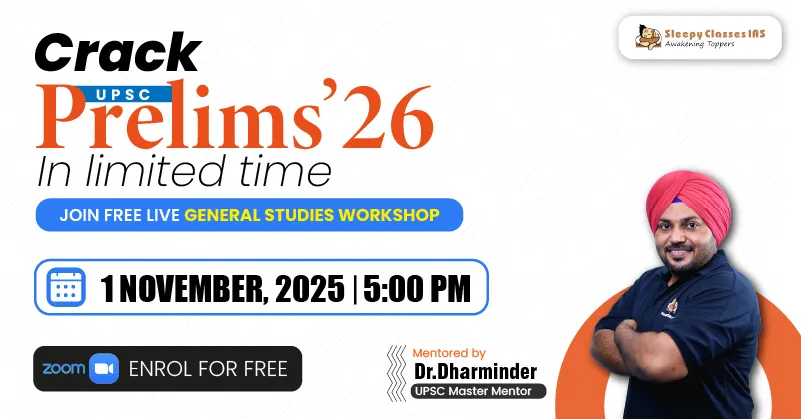The National Education Policy 2020, or NEP 2020, is shaking things up in India’s education system. This policy isn’t just about textbooks and exams; it’s about making learning more flexible and fun. It introduces a new structure for schools, focuses on skills and tech, and even brings in changes for teachers. But what does this mean for those eyeing the UPSC exams? Let’s dive into how NEP 2020 is a game-changer for education and its importance for UPSC aspirants.
Key Takeaways
- NEP 2020 introduces a fresh school structure, moving from the old 10+2 system to a new 5+3+3+4 model, focusing on different stages of learning.
- Vocational training and skill development become a big part of the curriculum, starting from a young age, to prepare students for real-world challenges.
- Teachers will see new training programs and standards, aiming to improve the quality of education across the board.
- Technology gets a spotlight in education, with digital tools and platforms enhancing learning, especially in remote areas.
- For UPSC aspirants, NEP 2020 themes are crucial for preparation, offering new insights and perspectives for exams.
Understanding the National Education Policy 2020
Key Objectives and Vision
The National Education Policy (NEP) 2020 sets out to transform the educational landscape of India by making learning more inclusive, flexible, and aligned with the needs of the 21st century. Aimed at nurturing the unique potential of every student, it focuses on holistic development rather than just academic excellence. The policy is built on five pillars: Access, Equity, Quality, Affordability, and Accountability. By 2030, the NEP aims for universal access to education from preschool to secondary level, ensuring no child is left behind.
Historical Context and Development
Approved by the Union Cabinet on July 29, 2020, NEP 2020 replaces the longstanding National Policy on Education of 1986. This shift was necessary to address the evolving educational needs and to position India as a global knowledge hub. The policy development involved extensive consultations, incorporating feedback from diverse stakeholders, including educators, students, and policymakers.
Impact on Indian Education System
The introduction of the NEP 2020 is a landmark moment for the Indian education system, promising significant changes. It introduces a new 5+3+3+4 curricular structure, replacing the traditional 10+2 system. This new framework is designed to be more aligned with a child’s cognitive development stages. Moreover, NEP 2020 promotes multilingualism by encouraging students to learn multiple languages, enhancing cultural understanding and communication skills. The policy also emphasizes vocational training from an early age, integrating it into the school curriculum to better prepare students for the job market.
The 5+3+3+4 Structure: A New Educational Framework
The 5+3+3+4 structure kicks off with the foundational stage, covering ages 3 to 8. This phase is all about play and activity-based learning, ensuring kids get the basics of literacy and numeracy down pat. It’s like laying the first bricks of a sturdy building, focusing on the child’s overall development, not just academics. This stage is crucial for setting the groundwork for future learning.
Next up, the preparatory stage spans ages 8 to 11. Here, education becomes more structured. Kids dive into subjects like science and math, but with a twist—it’s all about learning through discovery and interaction. The idea is to spark curiosity and encourage kids to ask questions, making learning a fun journey rather than a chore.
The middle stage, from ages 11 to 14, introduces students to a broader range of subjects. Think of it as a buffet of knowledge where they can sample everything from arts to sciences. Then comes the secondary stage, ages 14 to 18, where students start to specialize. They get to choose subjects that interest them, preparing for college or vocational paths. This flexibility helps cater to different learning styles and career goals.
The 5+3+3+4 framework isn’t just about changing numbers; it’s about reshaping how we think about education. It aims to make learning a more personalized and engaging experience, tailored to the 21st-century needs of students.
Vocational Education and Skill Development in NEP 2020
Integration into School Curriculum
The National Education Policy 2020 has made a significant push to blend vocational education with the traditional schooling system. The idea is to ensure that students get practical skills alongside academic knowledge. By 2025, the policy aims for at least 50% of students to have some exposure to vocational training. This includes hands-on internships with local businesses, which can provide real-world experience that textbooks just can’t offer. Vocational education isn’t just an add-on; it’s becoming a core part of the curriculum from Class 9 onwards.
Benefits for Students and Society
Vocational education offers a bunch of perks for students and the broader community. For students, it means being job-ready right out of school. They can develop skills that are directly applicable in the workforce, which can be a huge advantage in today’s competitive job market. For society, it means a more skilled workforce, which can boost productivity and innovation. Plus, it can help reduce unemployment rates by opening up new job opportunities.
Challenges and Implementation Strategies
While the benefits are clear, integrating vocational education isn’t without its challenges. One major hurdle is the lack of trained instructors who can teach these skills effectively. Then there’s the issue of resources—schools need the right tools and equipment to offer quality training. To tackle these issues, the policy suggests strategies like partnering with industry experts and investing in teacher training programs. Schools might also need to look at innovative solutions, like digital platforms, to provide these vocational courses.
“The integration of vocational education into mainstream schooling under NEP 2020 is a game-changer. It not only equips students with practical skills but also aligns education with the needs of the job market.”
Incorporating vocational training into the curriculum is a big step forward in making education more relevant and practical for students. This move is set to transform how education is perceived in India, aligning it more closely with the demands of the modern world. NEP 2020 aims to improve vocational education by emphasizing the importance of skill development and practical knowledge for all individuals.
Teacher Education Reforms Under NEP 2020
New Standards and Training Programs
The National Education Policy (NEP) 2020 is shaking up the teacher education system in a big way. Teachers are the backbone of any educational system, so the NEP is pushing for a revamp in how they are trained. The policy introduces a four-year integrated B.Ed. program that combines subject mastery, teaching skills, and practical experience. This program is designed to ensure that teachers are well-prepared to handle the diverse challenges of modern classrooms. With the focus on holistic development, this initiative aims to create educators who can inspire and adapt.
Continuous Professional Development
The learning journey for teachers doesn’t stop at graduation. NEP 2020 emphasizes ongoing professional development through digital platforms, workshops, and seminars. Teachers will have access to resources that help them keep up with educational trends and technologies. This continuous learning approach ensures that teachers remain effective and relevant, fostering an environment where both students and educators thrive.
Role in Enhancing Educational Quality
Teachers play a crucial role in enhancing the quality of education. With the reforms under NEP 2020, teachers are expected to be more than just knowledge providers; they are mentors and guides in the learning process. The policy encourages teachers to engage in research and innovation, contributing to a dynamic educational landscape. By focusing on teacher quality, NEP 2020 aims to uplift the entire educational system, ensuring that students receive a well-rounded and impactful education.
Technology Integration in Education: NEP 2020’s Approach
Digital Learning Tools and Platforms
The National Education Policy 2020 has put a spotlight on using technology to make learning more engaging and accessible. One of the key initiatives is the creation of the National Educational Technology Forum (NETF), which aims to provide a platform for free exchange of ideas on technology-based education. This forum is expected to drive innovation and address the challenges of integrating digital tools in classrooms.
Additionally, platforms like DIKSHA are being promoted to support teachers and students with digital resources. These platforms offer a range of materials such as video lectures and interactive content, which are especially useful in areas where traditional resources might be lacking.
National Educational Technology Forum
The NETF is envisioned as a central hub for discussing and implementing technology in education. It will focus on improving digital infrastructure and fostering collaborations between educational institutions and tech companies. The forum is also expected to guide the development of online courses and digital content that can be tailored to different learning needs.
Impact on Remote and Rural Education
Technology integration under NEP 2020 is particularly significant for remote and rural areas. By leveraging digital tools, students in these regions can access high-quality educational resources that were previously unavailable. This shift not only helps bridge the educational gap but also encourages a more inclusive learning environment.
With the push for digital learning, students across India, regardless of their location, can now benefit from a more connected and resource-rich educational experience. This move towards a digital-first approach is a step towards making education more equitable and inclusive.
Inclusion and Equity: Ensuring No Child is Left Behind
Focus on Marginalized Communities
The National Education Policy (NEP) 2020 is all about making sure every child gets a fair shot at education, no matter where they come from. This policy is particularly focused on helping children from marginalized communities. These include groups often left out, like girls, kids from economically weaker sections, and those with disabilities. To tackle these challenges, the NEP suggests setting up a Gender Inclusion Fund and Special Education Zones. These initiatives aim to give extra support where it’s needed most.
Gender Inclusion and Support
When it comes to gender, NEP 2020 is clear: girls should have the same educational opportunities as boys. The policy pushes for better facilities and resources to make schools more welcoming for girls. This includes everything from building safe school environments to providing scholarships and incentives to keep girls in school. The idea is to break down barriers that might stop girls from getting the education they deserve.
Infrastructure and Resource Allocation
Infrastructure and resources are crucial for making education accessible to everyone. NEP 2020 calls for improvements in school infrastructure, especially in rural and underserved areas. This means building more schools, improving existing ones, and ensuring they have the necessary resources like books, technology, and trained teachers. The policy also highlights the importance of using technology to reach students in remote areas, making education more inclusive and equitable.
The NEP 2020 is a bold step towards creating an inclusive education system that leaves no child behind. By focusing on marginalized communities, promoting gender equality, and improving infrastructure, it aims to provide quality education for all.
For more on how NEP-2020 emphasizes inclusion in mainstream education, check out ongoing concerns regarding the practical implementation.
Multilingualism and Cultural Diversity in NEP 2020
Promotion of Regional Languages
The National Education Policy 2020 is a significant step towards embracing the rich tapestry of languages in India. It promotes multilingualism by encouraging the use of regional languages in education, which can help students connect better with their cultural roots. The policy suggests that children should learn at least three languages, with a strong focus on the local or regional language. This approach not only supports linguistic diversity but also aids in cognitive development.
Benefits of Multilingual Education
Learning multiple languages has several advantages. It enhances cognitive abilities, improves problem-solving skills, and fosters a better understanding of different cultures. Students become more adaptable and open-minded, qualities that are crucial in today’s globalized world. Moreover, multilingual education can lead to better academic performance as students can grasp concepts more effectively in their mother tongue.
Challenges in Implementation
While the idea of multilingual education is appealing, it comes with its own set of challenges. One major hurdle is the availability of resources, such as textbooks and trained teachers, in various regional languages. Additionally, there might be resistance from some communities who prefer English or other dominant languages for perceived better career prospects. To address these issues, the policy allows states and students the flexibility to choose languages, provided at least two are included in the curriculum. This flexibility is crucial for encouraging multilingualism in education and helping regions tailor their educational strategies to local needs.
Multilingualism in education is not just about learning languages; it’s about opening doors to a world of cultural richness and understanding. By embracing our linguistic diversity, we pave the way for a more inclusive and harmonious society.
Higher Education Reforms: A New Era of Learning
Multidisciplinary and Flexible Curriculum
The National Education Policy 2020 (NEP 2020) is bringing a fresh approach to higher education in India. One of the standout features is the push for a multidisciplinary and flexible curriculum. This means students can now explore a mix of subjects, breaking away from the rigid boundaries of traditional courses. The idea is to create a more holistic learning environment where students can tailor their education to fit their interests and career goals.
A key aspect of this reform is the introduction of multiple entry and exit points in degree programs. Students can choose to leave with a certificate or diploma after completing a certain period, or continue to earn a full degree. This flexibility is designed to accommodate diverse learning paces and life circumstances, making education more accessible.
Research and Innovation Focus
NEP 2020 places a strong emphasis on research and innovation. The policy aims to establish Multidisciplinary Education and Research Universities (MERUs), which are envisioned to be on par with global institutions like IITs and IIMs. These universities will focus on cutting-edge research and innovation, fostering an environment where creativity and critical thinking are at the forefront.
Moreover, an Academic Bank of Credit will be set up to digitally store academic credits, allowing students to transfer credits across institutions. This system supports lifelong learning and helps students manage their educational journey flexibly.
Global Standards and Competitiveness
NEP 2020 aims to make Indian higher education globally competitive. By aligning with international standards, the policy seeks to enhance the quality of education offered by Indian institutions. This includes adopting best practices in teaching, research, and administration.
To achieve this, the policy encourages collaborations with foreign universities, allowing for exchange programs and joint research initiatives. Such collaborations are expected to broaden perspectives and bring new insights into the Indian education system.
The NEP 2020 is not just a policy; it’s a vision for a more inclusive and dynamic higher education landscape in India. With its focus on flexibility, innovation, and global standards, the policy is set to transform how education is perceived and delivered in the country.
For more insights into how NEP 2020 is reshaping education, check out our detailed overview.
The Role of NEP 2020 in UPSC Preparation
The National Education Policy 2020 (NEP 2020) is more than just an educational reform; it’s a framework that aligns closely with the needs of civil services aspirants. Understanding NEP 2020 is crucial for UPSC candidates as it touches upon themes that are integral to the exam, such as education policy, governance, and societal development. The policy’s emphasis on a holistic and multidisciplinary approach mirrors the UPSC’s demand for well-rounded knowledge across various subjects.
Incorporating NEP Themes in Essays
Writing essays in the UPSC exam is a task that requires depth of understanding and the ability to connect various themes. NEP 2020 provides a rich source of content for essay writing. Aspirants can explore topics like educational reforms, the role of technology in education, and the impact of policies on social equity. By weaving these themes into their essays, candidates can demonstrate a comprehensive grasp of current affairs and policy impacts.
Resources and Study Materials
To effectively prepare for UPSC with a focus on NEP 2020, aspirants should seek out resources that cover the policy in detail. This includes government reports, educational journals, and expert analyses. Additionally, integrating NEP 2020 themes into study routines can enhance understanding of broader topics like governance and social justice, making candidates more adept at tackling diverse questions in the exam.
NEP 2020’s introduction of a restructured governance framework, including the Higher Education Commission of India (HECI), is a significant topic for aspirants focusing on policy analysis and its implications on education quality and accessibility.
Challenges and Criticisms of NEP 2020
Implementation Hurdles
The National Education Policy 2020 is ambitious, but putting it into action is a whole different ball game. India is vast and diverse, and the policy’s sweeping changes need careful planning and coordination. One big challenge is the lack of resources—both in terms of funding and skilled personnel. Schools in rural areas, especially, might struggle with the infrastructure needed to support the new curriculum and teaching methods. Plus, training teachers to adapt to these changes is no small feat.
Concerns from Educators and Experts
Educators and experts have voiced worries about how some aspects of NEP 2020 might play out in reality. There’s a fear that the policy’s focus on multidisciplinary education might dilute the depth of subject expertise. Critics also point out that while the policy aims for inclusivity, it doesn’t fully address the existing disparities in educational access and quality across different regions. This could mean that students in underprivileged areas might not benefit as much from the reforms.
Balancing Tradition and Modernity
Finding the right mix between traditional educational values and modern needs is tricky. The NEP 2020 encourages moving away from rote learning to foster critical thinking and creativity. However, this shift requires a cultural change in how education is perceived by parents, students, and educators alike. There’s also the challenge of integrating new technologies without losing sight of traditional learning methods that have their own benefits.
While NEP 2020 aims to overhaul India’s education system, its success hinges on overcoming these challenges. The policy’s potential can only be realized if these hurdles are addressed with thoughtful strategies and inclusive planning.
The Future of Indian Education: Vision 2040
Long-term Goals and Milestones
By 2040, India aims to transform into a knowledge superpower. The NEP 2020 outlines a comprehensive vision to achieve this by focusing on universal access to education, enhancing quality, and promoting equity. Key milestones include achieving a 100% Gross Enrollment Ratio (GER) in school education by 2030 and a 50% GER in higher education by 2035. The policy also envisions the integration of technology and the promotion of multilingual education to prepare students for global challenges.
Potential Impact on Society and Economy
Education is the backbone of any society, and the reforms under NEP 2020 are expected to have a profound impact. By fostering critical thinking and creativity, the policy aims to produce a workforce that is not only skilled but also adaptable. This shift is anticipated to boost economic growth, reduce poverty, and enhance social cohesion. The emphasis on vocational training will equip students with practical skills, making them job-ready and reducing unemployment rates.
Role of Stakeholders in Achieving Success
The successful implementation of Vision 2040 requires the active participation of various stakeholders, including government bodies, educational institutions, teachers, and parents. A collaborative approach is essential to address challenges such as infrastructure development and resource allocation. Continuous feedback and adaptation will be key to ensuring the policy’s goals are met. Stakeholders must work together to create an inclusive and supportive educational environment that nurtures every child’s potential.
As we look towards 2040, it’s not just about changing the education system; it’s about changing lives. The commitment to education reform is a commitment to a brighter future for all.
As we look ahead to 2040, the landscape of education in India is set to transform dramatically. With advancements in technology and innovative teaching methods, students will have access to a wealth of resources that cater to their individual learning needs. This evolution aims to create a more inclusive and effective educational system, preparing students for the challenges of the future. To be part of this exciting journey and to enhance your learning experience, visit our website today!
Conclusion
The National Education Policy 2020 is a game-changer for India’s education system. It’s like a fresh breeze, aiming to make learning more about understanding and less about memorizing. With its focus on critical thinking and practical skills, NEP 2020 is set to prepare students for real-world challenges. But, like any big plan, its success depends on how well it’s put into action. This is where resources and trained teachers come into play. For those gearing up for exams like the UPSC, understanding these changes is crucial. Programs like Sleepy Classes’ NEEV can be a great help, offering structured guidance and support. In the end, NEP 2020 is not just about changing textbooks; it’s about changing mindsets, making education a tool for building a better future.
Frequently Asked Questions
What is the National Education Policy 2020?
The National Education Policy 2020 (NEP 2020) is a comprehensive framework aimed at transforming India’s education system. It focuses on holistic development, critical thinking, and vocational skills, and introduces a new 5+3+3+4 structure for school education.
How does the NEP 2020 change the school education structure?
The NEP 2020 replaces the old 10+2 system with a new 5+3+3+4 structure. This includes 5 years of foundational, 3 years of preparatory, 3 years of middle, and 4 years of secondary education, emphasizing hands-on learning and flexibility in subject choices.
Why is the NEP 2020 important for UPSC aspirants?
The NEP 2020 is significant for UPSC aspirants as it aligns with the themes of holistic development and critical thinking, which are crucial for civil services exams. Understanding NEP can help in essay writing and answering questions related to education reforms.
What role does technology play in NEP 2020?
Technology plays a big role in NEP 2020, with plans for digital learning tools, online platforms, and the creation of a National Educational Technology Forum to improve learning experiences, especially in remote areas.
How does the NEP 2020 address teacher education?
NEP 2020 aims to improve teacher education by introducing rigorous training programs, continuous professional development, and a focus on practical experience to enhance teaching quality.
What is the focus of vocational education in NEP 2020?
NEP 2020 emphasizes integrating vocational education into the school curriculum from Class 6 onward, aiming to equip students with practical skills and make them job-ready.
How does NEP 2020 promote inclusivity and equity?
NEP 2020 promotes inclusivity by focusing on marginalized communities, ensuring equal access to education, and providing support through scholarships and infrastructure development.
What are the challenges in implementing NEP 2020?
Challenges include ensuring adequate funding, infrastructure, and trained educators to effectively implement the policy across India’s diverse and vast education system.






